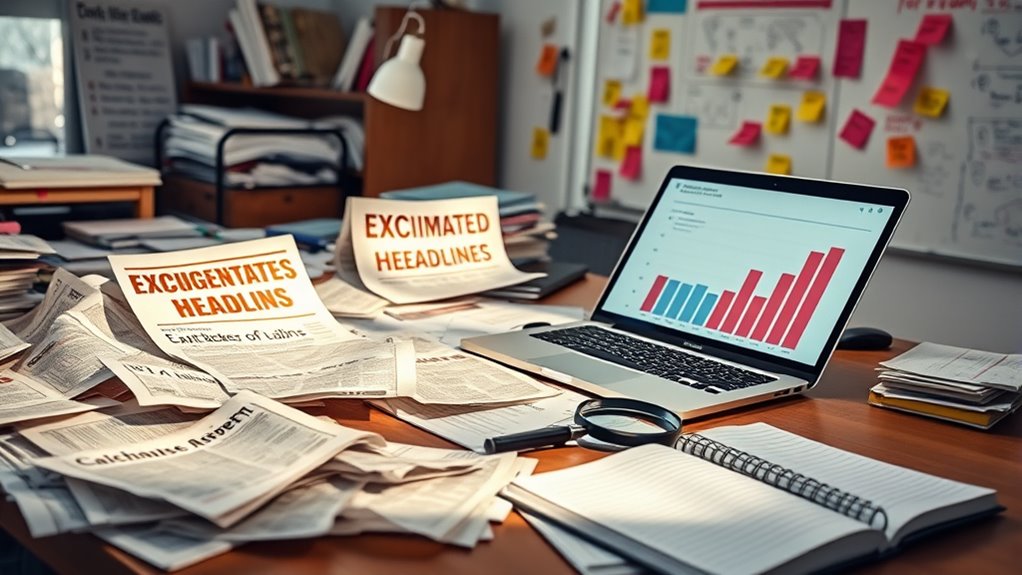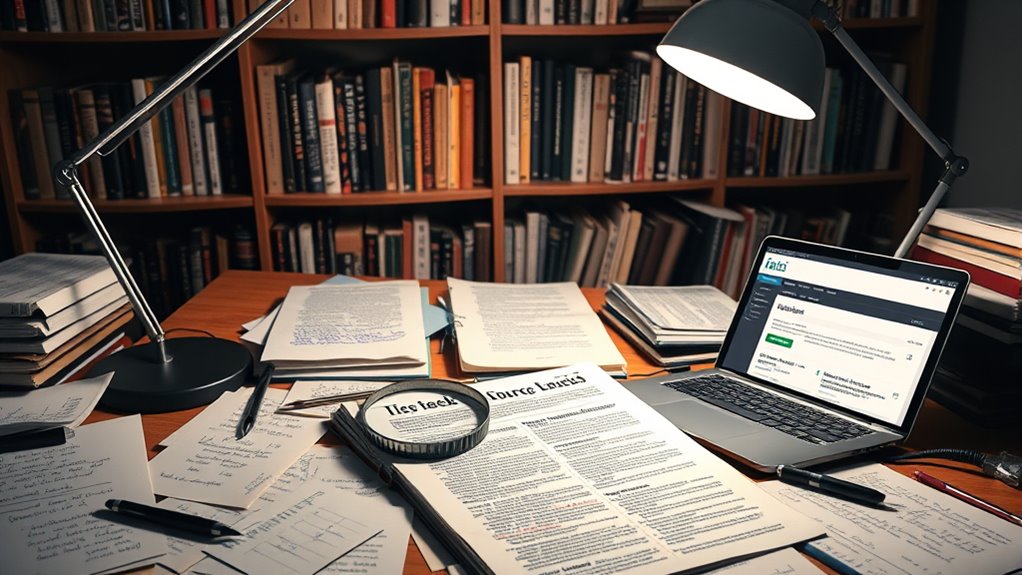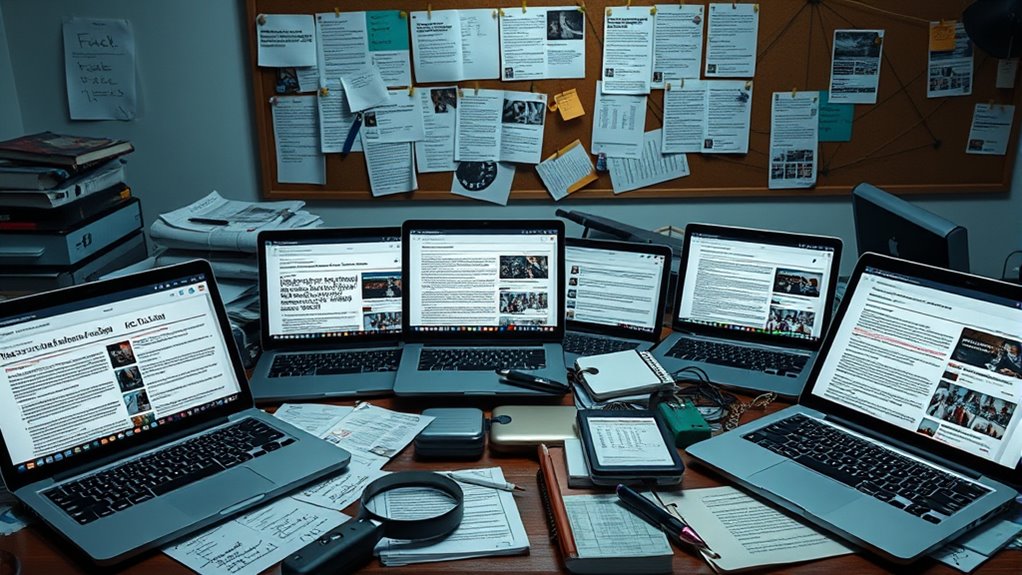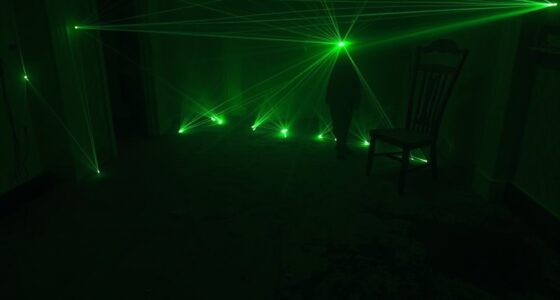To spot false alarms in investigations, start by recognizing common misinformation tactics like emotional appeals and sensational stories. Verify source credibility by checking authorship and reputation, and cross-check facts across multiple outlets. Analyze visual content carefully for signs of manipulation. Be aware of psychological biases like confirmation bias that cloud judgment. Use fact-checking tools and apply logical reasoning to evaluate claims. Engaging with expert opinions helps solidify your understanding—keep exploring to sharpen your skeptic’s toolkit.
Key Takeaways
- Recognize emotional appeals and sensational headlines that evoke fear or outrage to avoid being misled.
- Verify sources by checking authorship, reputation, and cross-referencing with trusted fact-checking sites.
- Use fact-checking tools and multiple independent reports to quickly confirm or debunk claims.
- Identify visual manipulation or discrepancies in media content to prevent accepting false narratives.
- Be aware of cognitive biases like confirmation bias and question assumptions to maintain critical thinking.
Recognizing Common Misinformation Tactics

Misinformation often relies on specific tactics designed to deceive or mislead. One common strategy is the use of misinformation campaigns that spread false or misleading content rapidly. These campaigns often employ emotional appeals to manipulate your feelings, making you more likely to accept false information without questioning it. You might notice sensational headlines or stories that evoke fear, anger, or outrage, which cloud your judgment. Such tactics aim to bypass logical thinking and tap into your emotions, making it harder to see through the deception. Recognizing these patterns helps you stay alert and cautious. By understanding that emotional appeals are often used to sway opinions, you can approach suspicious content with a more critical eye, reducing the chances of falling for misinformation.
Verifying Source Credibility and Authenticity

When evaluating information, checking the credibility and authenticity of your sources is a key step in avoiding deception. Start with source authentication—verify who created the information and whether they’re reputable. Look for signs of a credible source, such as clear authorship, institutional backing, or known expertise. Conduct a credibility assessment by examining the source’s reputation, past accuracy, and potential biases. Be wary of anonymous or anonymous-sounding outlets, and double-check if the source’s claims are consistent with established facts. Trustworthy sources typically provide verifiable evidence and transparent authorship. Additionally, source credibility is strengthened when sources have undergone thorough review processes or peer validation, making them more reliable. By thoroughly evaluating these factors, you reduce the risk of accepting false or misleading information, ensuring your investigations are built on a solid foundation of authentic and credible data.
Cross-Checking Facts Across Multiple Outlets

Cross-checking facts across multiple outlets is essential to verify the accuracy of information and identify potential discrepancies. Using source triangulation, you compare reports from different sources to see where they agree or differ. This approach helps you confirm a claim through claim corroboration, ensuring the information isn’t isolated or biased. When multiple outlets report the same facts independently, it boosts the credibility of the story. However, be cautious of false equivalencies—just because two sources agree doesn’t mean they’re both correct. Always evaluate each outlet’s credibility and look for corroboration across diverse, reputable platforms. Cross-checking helps you spot false alarms early and build a clearer picture of the truth, especially when sources have different perspectives or priorities. Additionally, understanding key factors like contrast ratio can aid in assessing the reliability of visual information in reports. Moreover, considering the diversity of sources involved can further strengthen your validation process, as it reduces the risk of bias influencing the overall assessment. Incorporating knowledge about AI detectors can also improve your ability to evaluate the authenticity of digital content, ensuring that reports are not artificially generated or manipulated. Recognizing local store hours and their variations can help you verify reports related to specific locations, preventing misunderstandings based on incorrect timing information. Being aware of regional reporting differences can help you identify biases based on geographic or cultural perspectives.
Analyzing Visual Evidence and Media Content

Visual evidence and media content play a crucial role in shaping perceptions of a story, but they can also be manipulated or misrepresented. Visual distortion occurs when images or videos are altered to convey a false narrative, making it essential to scrutinize their authenticity. Be wary of media manipulation, where digital editing or selective framing can mislead viewers. Check for inconsistencies, such as unnatural shadows, abrupt cuts, or unusual pixelation, which may indicate tampering. Consider the source of the media—are they reputable or known for sensationalism? Always question whether the visual content aligns with other evidence. Recognizing techniques like visual distortion and media manipulation helps you avoid falling for false alarms and ensures your assessments are based on genuine, reliable evidence. Additionally, understanding Ford Tuning techniques can help identify genuine modifications from fabricated or exaggerated claims in automotive media. Being aware of verification methods can further enhance your ability to discern authentic media from manipulated content.
Understanding Psychological Biases and Their Effects

Understanding psychological biases is essential because they shape how you interpret information and influence your judgments, often without you realizing it. Confirmation bias causes you to favor evidence that supports your existing beliefs while ignoring contradictory facts. This bias can lead you to dismiss valid evidence and reinforce false conclusions. Cognitive dissonance occurs when your actions or beliefs conflict, prompting you to justify or rationalize away uncomfortable truths, even if they’re accurate. Recognizing these biases helps you stay objective and skeptical. When you’re aware of confirmation bias and cognitive dissonance, you can actively challenge your assumptions and seek balanced evidence. This awareness is vital for avoiding pitfalls in investigations and ensuring your judgments are fair and well-informed.
Utilizing Fact-Checking Tools and Resources

You can quickly verify claims by using trusted fact-checking sites and cross-referencing multiple sources. Relying on these tools helps you spot misinformation before it spreads. When you verify information efficiently, you strengthen your ability to think critically and stay informed. Incorporating visual cues and organization strategies from home decor principles can also help you better interpret and assess information clarity. Utilizing trusted sources like fact-checking sites ensures the accuracy of your information validation process. Being aware of cultural variations in stories surrounding the Tooth Fairy can aid in understanding different perspectives and identifying potential myths.
Trusted Fact-Checking Sites
Trusted fact-checking sites are essential tools for anyone seeking to verify the accuracy of information online. They help you identify false claims, satire detection, and emotional appeals that often distort the truth. Reputable sites like Snopes, FactCheck.org, and PolitiFact provide clear explanations and sources, making it easier to see through misleading narratives. These platforms often analyze sensational headlines, social media posts, and viral stories, helping you distinguish between fact and fiction. By relying on trusted sites, you reduce the risk of spreading misinformation yourself. They also teach you to recognize common tactics used in false alarms, such as emotional appeals that manipulate your feelings instead of presenting facts. Understanding IRS regulations related to investments can also help you avoid scams and make informed decisions. Being aware of misinformation tactics used in false claims enhances your ability to critically evaluate information. Using these tools, you become a more effective skeptic, better equipped to navigate the information landscape and identify credible sources of information.
Cross-Referencing Sources
Have you ever encountered conflicting reports on the same topic? When that happens, cross-referencing sources becomes essential. This process uses source triangulation—comparing information from different outlets—and data triangulation—examining various data points—to verify accuracy. To do this effectively, consider these steps:
- Check multiple reputable sources to see if they report consistent facts.
- Use fact-checking tools to confirm the credibility of each source.
- Cross-verify data points across reports, studies, or official records to identify discrepancies.
Verifying Claims Quickly
Ever wonder how to quickly confirm if a claim is true? Using fact-checking tools and resources helps you do just that. Start with source triangulation—compare multiple credible sources to verify information rapidly. This approach reduces reliance on a single perspective and highlights inconsistencies. Bias awareness is vital; recognize potential biases in your sources to avoid skewed conclusions. Many online fact-checking sites, official databases, and reputable news outlets provide instant insights into disputed claims. By cross-referencing these tools, you can swiftly assess the validity of information. This not only saves time but also sharpens your skepticism, ensuring you rely on accurate, balanced data. Quick verification becomes a powerful step in your investigative toolkit, guarding you against false alarms and misinformation.
Applying Logical Reasoning and Critical Thinking

Applying logical reasoning and critical thinking is essential for evaluating claims and making sound decisions. By doing so, you can identify logical fallacies and cognitive biases that often distort judgment. To sharpen your skills, focus on three key strategies:
- Question assumptions: Challenge initial impressions and ask for evidence.
- Identify fallacies: Spot errors like false dilemmas or straw man arguments in arguments.
- Recognize biases: Be aware of tendencies such as confirmation bias that skew your perception.
These techniques help prevent faulty reasoning and ensure your conclusions are well-founded. Developing this skill set enables you to dissect claims objectively, avoid being misled by emotional appeals or logical errors, and foster a clearer, more rational approach to investigations.
Engaging With Expert Opinions and Peer Review

When engaging with expert opinions and peer review, you need to verify the credibility of your sources to guarantee trustworthy information. Analyzing the consensus among peers helps you understand how well-supported the ideas are, while evaluating the evidence rigor reveals the strength of the research. By applying these steps, you build a solid foundation for critical thinking and informed judgment.
Verifying Source Credibility
To determine if a source is credible, you need to examine whether it engages with expert opinions and has undergone peer review. This process helps identify credibility markers and reveals potential source bias. Check if the source cites reputable experts or institutions, indicating strong engagement with authoritative opinions. Look for indications of peer review, which ensures the information has been evaluated for accuracy and objectivity. Be cautious of sources that display obvious bias, as they might prioritize sensationalism over facts. Here are key steps to verify credibility:
- Confirm the source references well-known experts and peer-reviewed studies.
- Assess for signs of source bias that could skew the information.
- Look for credibility markers, such as transparent authorship and publication standards.
Analyzing Peer Consensus
Engaging with expert opinions and peer review is essential for understanding the consensus within a scientific community. Peer review filters out flawed research, helping you gauge the reliability of findings. Recognizing expert consensus can greatly inform your judgment on claims, especially when multiple specialists agree. Here’s a quick overview:
| Aspect | What to Look For | Why It Matters |
|---|---|---|
| Peer Review | Quality control process | Ensures research integrity |
| Expert Consensus | Majority agreement among scientists | Indicates well-supported conclusions |
| Source Credibility | Authority of the publishing body | Confirms trustworthiness |
| Replication | Reproducibility of results | Validates findings |
| Disagreements | Diverging expert opinions | Highlights ongoing debates |
Understanding these elements helps you critically assess scientific claims, avoiding false alarms.
Evaluating Evidence Rigor
Evaluating evidence rigorously involves critically examining the quality of expert opinions and the peer review process behind scientific findings. To avoid falling for misinformation patterns, you need to assess how evidence is interpreted and whether biases influence conclusions. Consider these key points:
- Scrutinize Expert Credentials: Check if experts have relevant expertise and avoid over-reliance on opinions that lack transparency or are influenced by conflicts of interest.
- Evaluate Peer Review Thoroughness: Ensure studies have undergone rigorous peer review, not just superficial approval, to confirm the validity of findings.
- Analyze Evidence Interpretation: Be wary of selective data or misrepresented results that distort the true significance, especially in complex scientific debates.
Developing a Systematic Approach to Debunking

Have you ever wondered how some skeptics quickly dismantle false claims while others struggle? The key is developing a systematic approach to debunking. Start by recognizing common pitfalls like confirmation bias, which can lead you to favor evidence supporting your beliefs and overlook contradictions. Next, identify logical fallacies in the claim, such as false dichotomies or appeals to emotion. Break down the investigation into clear steps: scrutinize the evidence, challenge assumptions, and seek credible sources. Maintain objectivity and avoid jumping to conclusions. Document your process so you can review your reasoning and ensure consistency. Over time, this disciplined approach sharpens your skills, making your debunking more effective and less prone to errors caused by bias or faulty logic.
Frequently Asked Questions
How Can I Identify Hidden Agendas Behind False Alarms?
To identify hidden motives behind false alarms, you should look for signs of manipulation tactics and inconsistent information. Ask questions about the source’s background and motives, and consider if there’s any potential benefit they might gain. Trust your instincts and analyze the evidence critically. Recognizing hidden motives helps you see through manipulation tactics, enabling you to determine whether the alarm is genuine or driven by ulterior motives.
What Legal Considerations Exist When Debunking Sensitive Misinformation?
When debunking sensitive misinformation, you need to contemplate legal liability and privacy concerns. You might face legal repercussions if your actions infringe on someone’s rights or spread defamation. Always verify facts carefully to avoid false accusations, and respect privacy by avoiding sharing personal details without consent. Staying informed about laws governing misinformation, privacy, and free speech helps you act responsibly while effectively debunking false claims.
How Do Cultural Differences Influence Misinformation Perception?
You should recognize that cultural differences substantially influence how misinformation is perceived. Cross-cultural biases shape your understanding, leading to perception gaps where you might misunderstand others’ beliefs or reactions. These biases affect how you interpret information, making it essential to approach each situation with cultural sensitivity. By understanding these influences, you can communicate more effectively and avoid misjudging the motives behind different perceptions of misinformation.
What Are Effective Strategies for Communicating Debunking Findings?
Imagine your message as a lighthouse guiding ships safely home. To effectively communicate debunking findings, you should use visual storytelling to clarify complex truths and foster trust. Engage your audience by making information relatable and memorable, turning abstract facts into vivid images. This approach keeps your audience attentive, helps them absorb details better, and ultimately strengthens the impact of your message, ensuring they understand and remember your key points.
How Can Technology Aid in Tracking the Origin of False Reports?
Technology helps you track false reports by leveraging data analysis and forensic tools. You can analyze patterns, identify suspicious sources, and trace the origin of misleading information quickly. Forensic tools assist in examining digital footprints and verifying authenticity. By combining these technologies, you gain a clearer picture of where false reports originate, enabling you to respond faster and prevent future misinformation from spreading.
Conclusion
Now that you know the tools and tactics, are you ready to uncover the truth lurking behind the headlines? With your newfound skills, you can spot deception before it spreads. But beware—misinformation evolves, and so must your approach. Will you be able to stay one step ahead, questioning and verifying every claim? The next false alarm could be just around the corner. Stay sharp, and trust your critical eye to reveal what’s real.









